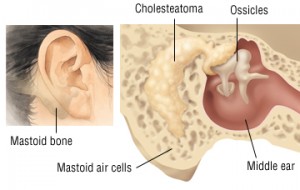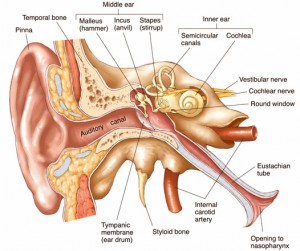What Causes Hearing Loss in a Normal Ear?
The ear is commonly divided into three segments: the external ear which includes the ear lobe and ear canal, the middle ear which includes the ear drum and the ear bones, and the inner ear which houses the hearing organ and the nerve that travels from the ear to the brain. the middle and inner ear represent delicate structures that, when exposed to long term infection and disease, can lead to hearing loss. This hearing loss can either be temporary or permanent. Many times, your doctor will be unable to guarantee the return of your child’s hearing loss. However, many times a good estimate of hearing “reserve” can be made from the initial hearing test.
 What are Ear Drum Perforations and Ear Drainage?
What are Ear Drum Perforations and Ear Drainage?
The ear drum may develop a hole, (or perforation), due to trauma or infection. In most instances, ear drum perforations caused by infection will close after the infection resolves. However, some perforations are too large to close spontaneously and will become infected causing drainage from the ear. When this occurs, your doctor’s first priority is to treat the infection and provide your child with a “safe” ear. This will prevent further hearing loss and damage to the ear due to infection. Once the child’s ear infection has cleared, discussion can then take place regarding repair of the perforation.
What is Cholesteatoma?
Sometimes, a perforation has been there for several months or years and skin within the ear canal will grow into the middle ear causing a cholesteatoma. A cholesteatoma is a cyst made up of skin. There is usually a large amount of skin debris associated with the cholesteatoma. A cholesteatoma is a slow-growing mass that may erode adjacent structures including the middle ear bones, (malleus: “hammer”, incus: “anvil”, and stapes: “stirrup”) and the bone surrounding the ear next to the brain. Cholesteatomas may also erode into the balance and hearing organs of the inner ear. For this reason, cholesteatomas are best removed early, once they are discovered. Many times, your doctor will try to control infection prior to removing the cholesteatoma in order to make the operation more successful.
In rare instances, a cholesteatoma may form due to skin tissue that is trapped behind the tympanic membrane during fetal development. In this instance, there will be no history of tympanic membrane perforation or significant ear infections. These cholesteatomas usually represent small “Pearls” or cysts that are directly attached to the inner surface of the tympanic membrane or one of the ear bones. Many times, these cholesteatomas can be removed in a single operation requiring no further surgical therapy.
How is Chronic Ear Disease Diagnosed?
To decide what form of therapy is best, your doctor may examine your child under an operating microscope in the office. This will allow better visualization of the problem and give clues to the extent of your child’s ear disease. When a cholesteatoma is suspected of involving more than the area behind the ear drum, a computed tomography (CAT) scan will be used. This is a special x-ray that allows your doctor to examine in detail the area behind the ear drum as well as the area of the mastoid bone which is located directly behind the ear.
Your doctor will order a hearing test to assess any hearing loss that may be present prior to therapy. If your child has signs of dizziness or unsteadiness associated with the cholesteatoma, your doctor may also order some other specialized tests of the balance system to help determine the extent of ear disease.
What Medical Therapy is Available for Ear Disease?
In treating chronic ear infections, it is vitally important to follow your doctor’s instructions and continue the medications even if you suspect your child’s ear disease is getting much better. Many times, your doctor will order antibiotics by mouth and ear drops. He may ask you to irrigate the affected ear with a special solution in order to rinse out debris, pus and other elements of chronic infection. Your child may require hospitalization or home intravenous therapy in order to treat some bacteria that infect the ear and mastoid which cannot be treated with oral antibiotics. All of these methods can result in complete resolution of chronic ear disease. It is your responsibility to follow through with every form of therapy prescribed as well as routine follow-up visits so the doctor can assess your child’s progress.
What Surgical Therapy is Available for Chronic Ear Disease?
If medical therapy is unsuccessful, or if the extend of the disease determined by your child’s evaluation is thought to involve the mastoid, your doctor will discuss with you surgical therapy tailored specifically to your child. This therapy may be directed at the area just behind the ear drum or to the mastoid bone behind the ear, or both.
If an operation such as this is necessary, it is important for your to fully understand the complexity and the risks associated with these surgeries. Your doctor has been specifically trained to perform this surgery using microsurgical instruments on the ear and mastoid. This is done with a microscope. Many times, in order to successfully remove all the chronic disease in your child’s ear, one of the ear bones will be disconnected to insure complete removal of disease and prevent further complications. Once your child’s ear disease is under control, your doctor will be able to, in many instances, reconstruct the hearing bones and restore much of the hearing lost to the chronic ear infection.
If your child suffers from an extensive cholesteatoma, the standard of care involves removing the cholesteatoma during the first operation and having a follow up or “second look” operation approximately four to six months after the initial removal. At this time, your doctor will have the opportunity to reconstruct the ear if it is appropriate.
Your doctor will discuss with you the risks of the surgery and the possible complications. Depending on the type of operation performed, the risks of surgery may change, but basically include bleeding, infection, further hearing loss, dizziness, tinnitus (ringing in the ear), facial paralysis and deafness.
What about Postoperative Care?
Your doctor will provide you with a separate sheet outlining the care of your child in the immediate postoperative period. It is important that you follow these instructions closely as THIS WILL DETERMINE A SUCCESSFUL OUTCOME FOR YOUR CHILD JUST AS MUCH AS A SUCCESSFUL OPERATION.
You are encouraged to ask questions of your doctors or the nursing staff at any time during the evaluation and treatment of your child. Chronic ear disease is a complex and very individualized disease process and, therefore, we encourage you to ask as many questions as you want in order to feel comfortable with your child’s care.


